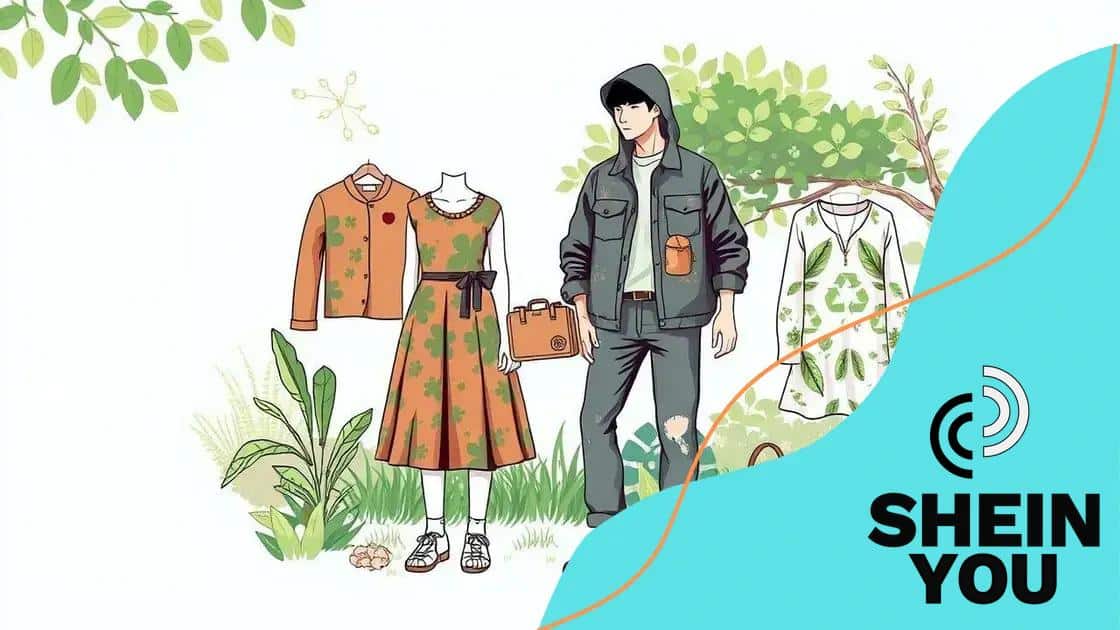Shein’s impact on global clothing markets: a closer look

Advertisements
Shein’s impact on global clothing markets includes driving fast fashion trends, influencing consumer behavior towards rapid purchases, and raising sustainability concerns that affect local brands.
Shein’s impact on global clothing markets is more than just a trend; it’s a phenomenon that’s changing how we shop and perceive fashion. Have you noticed how styles are evolving faster than ever? Let’s explore what’s driving this change.
Advertisements
The rise of fast fashion: Shein’s journey
The rise of fast fashion has transformed the clothing landscape, and Shein has been at the forefront of this revolution. This popular online retailer has captured the attention of consumers worldwide with its trendy and affordable clothing.
Understanding Fast Fashion
Fast fashion refers to clothing produced quickly in response to the latest trends. Shein exemplifies this model, offering a vast array of styles that change almost daily. Shoppers can find everything from casual wear to party outfits with just a few clicks.
- Rapid production cycles
- Affordable pricing
- Wide variety of styles
- Influence from social media trends
This approach not only meets the demand for new styles but also keeps customers coming back for more. With a strong social media presence, Shein leverages platforms like Instagram and TikTok to promote its latest collections. This strategy creates a sense of urgency and excitement around its products.
Advertisements
Impact on Consumer Behavior
Consumers are increasingly drawn to the convenience and variety that Shein offers. Many shoppers love the ability to find the latest fashions without breaking the bank. However, this behavior comes with challenges.
- Impulse buying is common
- Short-lived trends create waste
- Concerns over ethical production practices
The lure of fast fashion often trumps considerations like sustainability and ethical sourcing. As more people become aware of these issues, there’s a growing debate around the true cost of fast fashion, particularly as it relates to Shein.
Despite these concerns, Shein continues to thrive, attracting millions of shoppers worldwide. By understanding its journey and influence, consumers can make more informed choices about their clothing purchases, balancing trends with responsibility.
Consumer behavior changes in online shopping
The rise of online shopping has significantly altered consumer behavior, especially in the fashion industry. With easy access to a variety of brands, shoppers are experiencing a shift in how they choose and buy clothes.
Impact of Convenience
Online shopping provides unmatched convenience. Customers can browse a wide selection of clothing from anywhere at any time. This means they no longer need to visit multiple stores to find what they like. Instead, they can compare prices and styles with just a few clicks.
- Instant access to trends
- Ability to shop from home
- Easy comparison of different brands
- 24/7 shopping availability
The convenience of online shopping encourages more frequent purchases. Instead of planning a shopping trip, consumers are now more likely to buy clothes on impulse. This shift leads to higher sales volumes for brands like Shein.
Influence of Social Media
Another major factor affecting consumer behavior is social media. Platforms like Instagram and TikTok showcase fashion influencers who promote the latest trends. These social media trends can create immediate demand, influencing customers to buy items they see online.
This influence often leads to fast-paced consumer decisions. Shoppers might feel pressured to keep up with trends, resulting in a faster turnover of clothing. This behavior, while exciting, raises questions about sustainability and the ethical implications of such fast consumption.
Moreover, consumers today are more aware of their shopping habits. Many seek transparency from brands about where and how products are made. This awareness is pushing retailers to adopt better practices and improve their communication with customers.
In summary, the evolution of online shopping is continuously shaping consumer behavior. As convenience and social media continue to influence buying patterns, it’s crucial for brands to adapt and respond to the new landscape.
Sustainability concerns surrounding Shein

Sustainability concerns surrounding Shein are becoming more prominent as consumers demand transparency in fashion. The rise of fast fashion has led to questions about environmental impacts and ethical practices.
Environmental Impact
The production of clothing, especially in high volumes, contributes heavily to environmental degradation. Shein produces vast quantities of clothing quickly, which results in increased waste. Many items are discarded after just a few uses, leading to overflowing landfills.
- Excessive water usage in fabric production
- Pollution from dyes and chemicals
- Carbon footprint from shipping
- Fast fashion trends contribute to waste
These environmental impacts are prompting discussions about sustainability. Consumers are starting to look for eco-friendly alternatives and are becoming more aware of how their purchasing decisions affect the planet.
Ethical Production Practices
Alongside environmental issues, there are concerns about the working conditions in factories that produce Shein clothing. Reports have surfaced about low wages and poor labor conditions in some factories.
This raises ethical questions about how products are made and the responsibility of companies to their workers. Shoppers are increasingly seeking brands that prioritize fair labor practices and ethical sourcing.
Many consumers now look for certifications that indicate a brand is committed to sustainability and ethical standards. This shift in consumer behavior is pushing brands, including Shein, to rethink their practices and align more closely with what customers want.
As awareness grows, the fashion industry must adapt. Both environmental and ethical considerations will likely shape the future of fashion shopping, including how Shein operates.
Global competition: How Shein affects local brands
Global competition in the fashion industry is intensifying, and Shein plays a significant role in this trend. As a leading fast fashion retailer, Shein’s business model impacts local brands around the world, forcing them to adapt and compete in new ways.
Shein’s Business Model
Shein operates on a unique business model that emphasizes speed and affordability. By producing new styles continually and at low prices, Shein attracts a large customer base. Their ability to quickly respond to trends means that they can offer what consumers want almost immediately.
- Rapid design and production cycles
- Direct-to-consumer sales online
- Use of data analytics to predict trends
- Engagement with influencers for marketing
This fast-paced approach poses challenges for local brands that may not have the same resources or infrastructure as large companies like Shein. Many local brands find it challenging to compete with such low prices and rapid turnover of styles.
Impact on Local Markets
The presence of Shein can significantly disrupt local markets. As shoppers are drawn to the affordability and variety offered by Shein, local brands may see a decline in sales. This can lead to reduced market share and diminished brand loyalty for traditional retailers.
Moreover, local fashion businesses often focus on quality and craftsmanship. While they may offer unique designs, the challenge is to communicate these values to consumers who prioritize price and convenience. Many local brands are now exploring ways to differentiate themselves by emphasizing sustainable practices and unique offerings.
In response to these challenges, some local brands are adopting new strategies. This includes collaborating with influencers and utilizing online platforms to reach a broader audience. By harnessing social media and online marketing, they aim to connect with consumers who are looking for more than just fast fashion.
Ultimately, the competition from Shein pushes local brands to innovate and adapt. This dynamic landscape encourages a focus on quality, sustainability, and unique consumer experiences, which can help local businesses create a loyal customer base.
Future trends in fashion influenced by Shein
Future trends in fashion are being significantly influenced by Shein and its fast fashion model. As consumer preferences shift and the market evolves, several key trends are emerging.
Speed and Variety
The demand for quick access to the latest styles is driving the fashion industry. Shein excels at producing a wide variety of clothing rapidly, allowing shoppers to find new pieces almost every week. This fast-paced approach is likely to set the standard for other retailers.
- Increased investment in technology for rapid production
- Growth of collections inspired by viral trends
- More frequent launches of new products
- Use of data analytics for trend prediction
As brands strive to keep up with this tempo, consumers may expect more options and quicker updates to collections. This could lead to a more dynamic shopping experience where trends evolve at a breakneck pace.
Sustainability Efforts
While Shein has faced criticism for its environmental impact, there are growing calls for sustainability in fashion. As awareness around environmental issues rises, many consumers are demanding eco-friendly options.
This trend could push Shein and similar brands to enhance their sustainability efforts. Potential developments may include:
- Use of recycled materials in clothing
- Reduction of waste in production processes
- Transparency in sourcing and labor practices
- Investment in sustainable practices and technologies
As brands adapt to consumer demands, we may see a shift toward more responsible fashion that balances style with environmental considerations.
In addition to sustainability, the rise of social media influencers continues to shape trends. Brands are likely to increasingly collaborate with influencers to reach niche markets and promote the latest styles. This phenomenon reinforces the connection between digital trends and fashion, creating a vibrant marketplace that responds quickly to consumer interests.
Overall, the influence of Shein is steering the fashion landscape towards faster production, increased variety, and an emphasis on sustainability and social media engagement. Keeping up with these trends is crucial for brands aiming to remain relevant.
In summary, Shein has a significant impact on the fashion industry, shaping trends and consumer behavior. The rise of fast fashion has driven brands to adapt quickly, while also raising sustainability concerns. As the market evolves, we can expect a focus on speed, variety, and responsible practices. Understanding these trends is essential for brands and consumers alike, as they navigate the changing landscape of fashion.
FAQ – Frequently Asked Questions about Shein’s Impact on Fashion
How does Shein influence global fashion trends?
Shein influences global fashion trends by offering rapidly changing styles at low prices, encouraging other brands to adapt quickly to consumer demands.
What are the sustainability concerns related to Shein?
Sustainability concerns include environmental impact from fast fashion production, such as waste and pollution, and the need for more eco-friendly practices.
How does Shein affect local fashion brands?
Shein’s competitive pricing and fast production can make it difficult for local brands to compete, often resulting in decreased sales and market share.
What should consumers consider when shopping from fast fashion brands like Shein?
Consumers should consider the environmental impact, the ethical practices of brands, and the importance of supporting sustainable and local businesses.